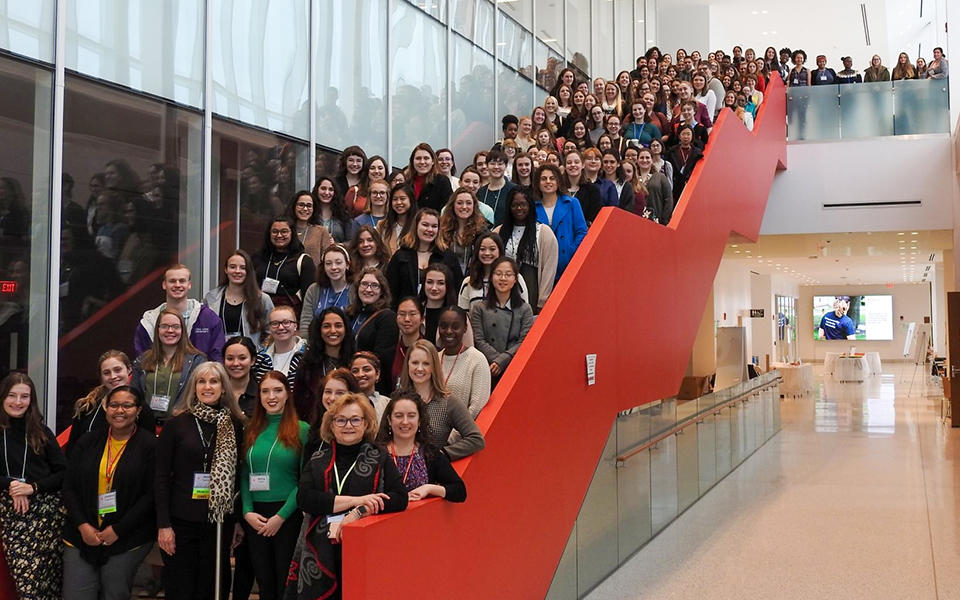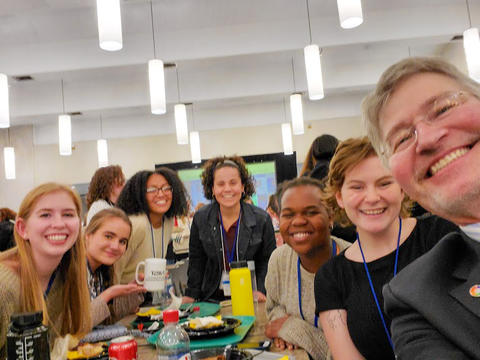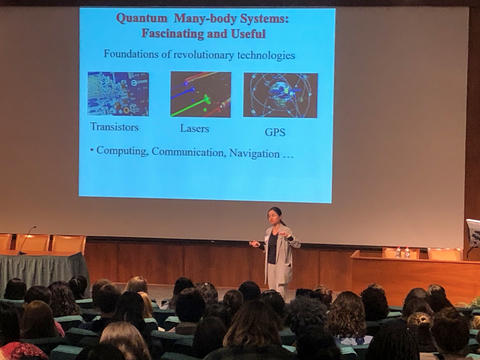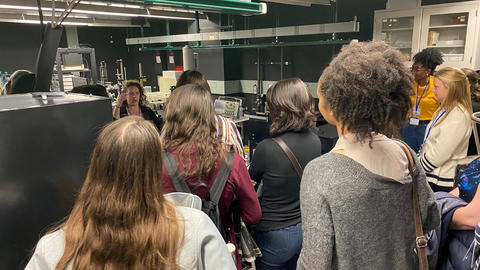Taking Measure
Just a Standard Blog

Earlier this year, NIST and the University of Maryland co-hosted a Conference for Undergraduate Women in Physics (CUWiP), which brought together about 160 undergraduate women and gender minorities majoring in physics for a weekend of networking, plenary talks, laboratory tours, panel discussions and workshops.
Inclusivity is a core value at the National Institute of Standards and Technology (NIST), and we strive to make it a welcoming place for all. At the start of 2020, NIST and the University of Maryland (UMD) co-hosted the Conference for Undergraduate Women in Physics (CUWiP), which brought dozens of NIST and UMD volunteers, scientists and staff together to inspire about 160 undergraduate women to continue their pursuit of degrees in physics. The sheer scale of the event was exciting to witness and made me proud to be a part of an institution that values outreach in addition to research excellence.
I know the value of data. And although I will always advocate for empowering women in all fields of science, technology, engineering and math (STEM), the data tells us that the situation is especially troublesome for physics as a discipline. Statistics on demographics collected from the American Institute of Physics, the Higher Education Research Institute, and the Integrated Postsecondary Education Data System have shown that while women make up nearly 50% of enrollments in high school physics, chemistry and biology, less than 20% of postsecondary physics majors are female, while chemistry and biology remain relatively stable at above 40%.
Anyone in the physics community can see this disparity for themselves. At the University of Pittsburgh, where I got my bachelor’s degree in physics, my higher-level classes had only about five women out of 30 students. Only one of my professors was a woman. Then, in my Ph.D. program at Penn State, there were three female graduate students in my class, and none of my physics classes were taught by a woman. It can be disheartening to look around at a physics conference and be able to count the number of women on one hand, or to look out while giving an invited talk and see mostly male faces. Feeling like you belong in a field can be difficult when you do not see many role models who look like you, speak like you, or share a similar background or upbringing. Representation helps foster the confidence of bright young women who wish to succeed in STEM.
“I became a physics major after attending CUWiP two years ago, and during this CUWiP, I realized that there are multiple paths that I can take as a physicist post-graduation. My future seemed clearer to me after attending CUWiP this year, which is something that I am very happy about.” — CUWiP attendee
That’s where CUWiP comes in. CUWiP is a group of simultaneously held regional conferences targeted at recruiting and retaining undergraduate women interested in physics. The conferences, which are spearheaded by the American Physical Society, encourage undergraduate women to pursue careers in physics by providing them with the experience of a professional conference without any of the financial burden. The conferences are funded by the National Science Foundation, the Department of Energy and a variety of sponsors through fundraising efforts by the host institutions. Travel is generally supported by the students’ schools.

The first CUWiP was held at the University of Southern California in 2006 with 27 attendees. It rapidly expanded such that within a few years, there were multiple conferences with almost 2,000 attendees per year. I’m glad that every undergraduate woman majoring in physics now has the chance to attend at least one CUWiP. Some of the goals of the conference include creating a sense of community among undergraduate women in physics, introducing female role models, sharing career paths and struggles, and developing skills that are key in professional development and career planning.
During my graduate studies, I was on the organizing committee for a CUWiP hosted at Penn State in 2014, where I directly observed the lasting impression this conference leaves on its attendees. Coincidentally, the same year that we hosted a CUWiP at Penn State, one of the other conference sites was at NIST and UMD, led by the late Katharine Gebbie (NIST), Angie Hight Walker (NIST) and Donna Hammer (UMD). When Angie, who is my postdoctoral mentor, approached me in early 2019 to help lead another conference in 2020, I was thrilled and immediately said yes!
“I feel so much less lost now. I also now have people I can contact if I need help with anything.” — CUWiP attendee
Angie, Donna, Josiland Chambers (UMD) and I spent a year setting up the agenda for our approximately 160 CUWiP 2020 attendees. The students, who traveled from all over the East Coast and even as far west as Tennessee, came from many different backgrounds, including large research universities, smaller liberal arts colleges, historically black colleges and universities, and community colleges. They ranged from freshmen to seniors, from first-generation college students to those with parents in STEM, and from already declared physics majors to those who were still undecided.

The conference began at NIST with NIST Director and Under Secretary of Commerce for Standards and Technology Walter Copan introducing the students to NIST and sharing personal stories of what sparked his interest in science. After a networking lunch with over 25 female NIST scientists, Ana Maria Rey, who is a fellow of NIST and JILA (a joint institute of NIST and the University of Colorado Boulder), gave a talk entitled “Building with Crystals of Light and Quantum Matter: From Clocks to Computers.” Many of the attendees expressed their appreciation for how she was able to make such a complicated topic understandable and enjoyable.
After a much-needed coffee break, CUWiP attendees took lab tours around the NIST campus, including a trip to the NIST Center for Neutron Research (NCNR). Most of the lab tours were given by female scientists, affirming that women are successfully applying their skills at the lab bench. The day ended with a fantastic talk by Nobel Prize winner Bill Phillips on the redefinition of the International System of Units. Many students said Bill’s talk was a highlight of their conference experience, with one writing, “This was my absolute favorite part of the entire weekend! Dr. Phillips is such an entertaining and talented speaker, as well as an all-around great person!” Bill stayed well after his talk to engage with the students and entertained many inquiries; the students absolutely loved it. Eventually, we had to push the students out the door so the buses could depart.
The rest of the conference took place in College Park at UMD. It started with panels of successful women physicists, including discussions on the intersection of technology and policy, life as a graduate student, research experience for undergraduates, diverse careers in physics, and navigating a career in STEM as a member of the LGBTQ+ community. The evening program featured a poster session with over 40 undergraduate student presenters and a banquet with plenary speaker Ellen Williams, distinguished professor at UMD, where she discussed the role all of us can play in combating climate change.

The next day consisted of workshops on communication and negotiation skills, building and presenting physics demonstrations, networking and job searching with LinkedIn, and applying to graduate school, among other topics. The conference finished with lab tours at UMD. Exhausted, yet full of confidence and excitement for physics, the students left for their home institutions.
A ton of work and a lot of helping hands go into planning a conference of this size. Many female NIST scientists took time to network with the attendees, and scientists/staff (both male and female!) either opened their laboratories for tours, escorted the attendees between tour stops or helped put together a decadent coffee break for the attendees. It was especially inspiring to have active participation in CUWiP from leadership at NIST.
“I have never been a part of [something with] such like-minded and goal-oriented women and it gives me such confidence and inspiration for my future. Also, the workshop about diverse careers in physics showed me that there is so much more to a physics degree than I ever expected.” — CUWiP attendee
During the two weeks before the conference, when I felt as if I was drowning in details and my stress levels hit the roof, at times it was hard to remember the bigger picture. But seeing all the effort come to fruition, and then having multiple attendees approach me to tell me how much the experience meant to them, reminded me of just how significant events like these are in shaping the future of physics. As Women’s History Month ends, it seems the perfect time to share this highlight about CUWiP and the immense amount of work put in by many people, both inside and outside of NIST and UMD, female and male, that led to its success. I hope this gets people thinking about ways to increase diversity and inclusion in physics and brings us closer to the day when women are equally represented in the physics community.





